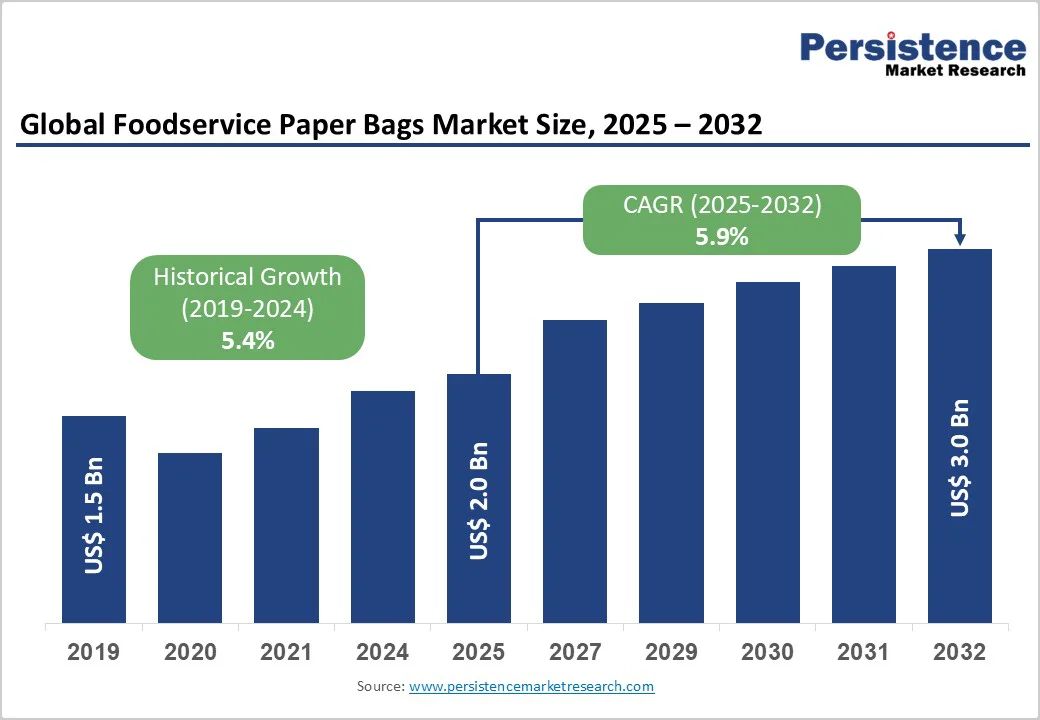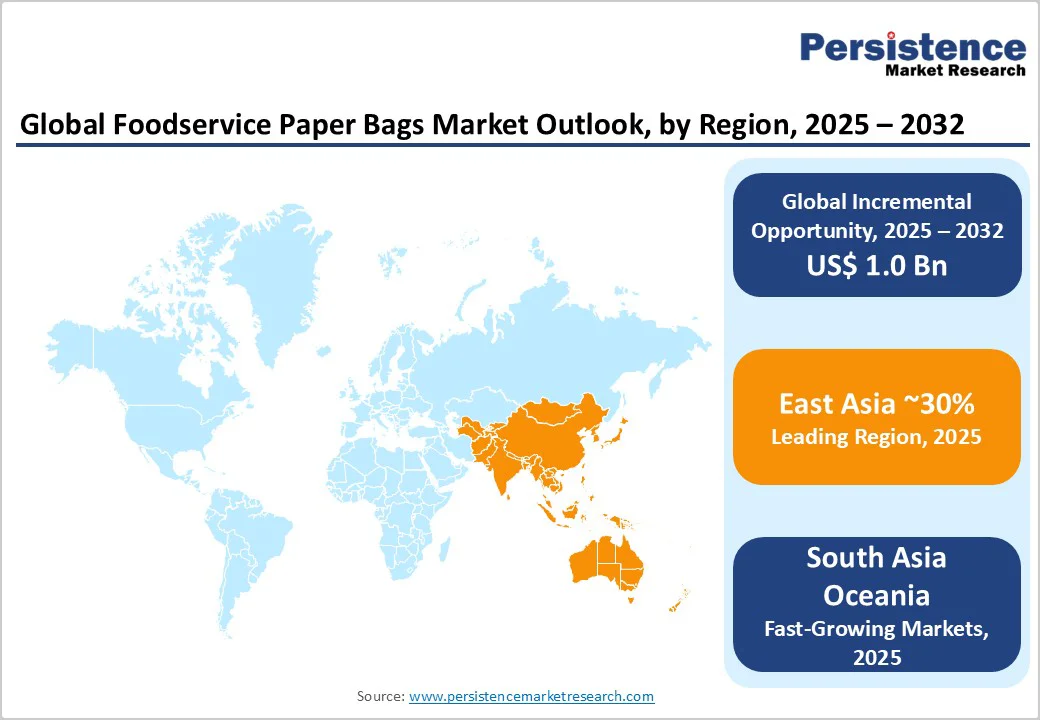ID: PMRREP35833| 188 Pages | 10 Nov 2025 | Format: PDF, Excel, PPT* | Packaging

The global foodservice paper bags market is expected to reach US$2.0 billion in 2025. It is projected to reach US$3.0 billion by 2032, growing at a CAGR of 5.9% during the forecast period 2025 - 2032.
This expansion reflects a fundamental structural shift in food packaging procurement driven by stringent regulatory frameworks prohibiting single-use plastics, accelerating consumer preference for biodegradable alternatives, and the rapid proliferation of online food delivery platforms across developed and emerging economies.
The market's trajectory demonstrates resilience in core foodservice applications, with momentum in quick-service restaurants (QSRs) and third-party delivery services where operational convenience and environmental compliance intersect.
| Key Insights | Details |
|---|---|
| Foodservice Paper Bags Market Size (2025E) | US$2.0 Bn |
| Market Value Forecast (2032F) | US$3.0 Bn |
| Projected Growth (CAGR 2025 to 2032) | 5.9% |
| Historical Market Growth (CAGR 2019 to 2024) | 5.4% |

Regulatory prohibitions on single-use plastics are the most significant structural catalysts driving growth in the foodservice paper bags market. For instance, the European Union (EU)'s Packaging and Packaging Waste Regulation (PPWR), effective August 12, 2026, mandates full recyclability of all packaging by 2030 and explicitly bans single-use plastic packaging for fresh fruit and vegetables weighing less than 1.5 kilograms.
Similarly, California's amended SB 1046 restricts the distribution of non-compostable pre-checkout bags effective January 2025. These regulatory mechanisms actively transfer packaging selection authority from business discretion toward legal mandate, creating structural substitution demand independent of consumer preference or cost-benefit calculations.
Consumer preference for sustainable packaging has evolved from a discretionary choice into a core purchasing determinant. A comprehensive survey by Japan's Consumer Affairs Agency found that 76% of Japanese consumers actively select restaurants that prioritize sustainable packaging, with 82% explicitly favoring paper-based alternatives over plastic.
South Korea's Ministry of Environment recorded a surge in customer preference for eco-friendly packaging, from 52% in 2020 to 71% in 2023. These behavioral indices translate into competitive differentiation mechanisms, whereby branded foodservice providers that incorporate visible sustainability attributes command premium positioning and customer retention advantages.
Paper bags manufacturing cost structure demonstrates heightened sensitivity to virgin fiber pulp pricing, which exhibits pronounced cyclicality driven by forestry operations, trading dynamics, and macroeconomic conditions. The cost of kraft paper, for instance, is subject to seasonal supply variations, geopolitical influences on timber sourcing, and energy-intensive production processes.
Paper manufacturing accounts for approximately 7% of global industrial energy consumption, establishing a direct correlation between petrochemical prices and input costs. European paper industry data documents total mill capacity declining from 1,570 to 861 facilities between 2000 and 2023, reflecting structural consolidation and increasing supplier concentration risk.
Manufacturers lacking integrated vertical supply chains and dependent on spot-market procurement face margin compression during cost-escalation phases, potentially constraining production capacity expansion and competitiveness against alternative packaging materials. This structural restraint will persist, particularly for smaller regional converters, potentially concentrating market consolidation among integrated producers maintaining proprietary pulp sourcing capabilities.
The Asia Pacific foodservice industry is experiencing accelerated growth driven by rapid urbanization, expanding middle-income populations, and the proliferation of quick-service restaurant networks, thereby amplifying demand for paper bags.
India's packaging sector, constituting the fifth-largest industry globally at US$86 billion in 2024 with 22-25% annual growth, provides context for emerging market scale. Structural expansions in emerging markets can, therefore, generate volume opportunities for manufacturers establishing regional production footprints and localized supply chains, distinct from mature market saturation dynamics.
Advanced materials science developments in grease-resistant and moisture-barrier coating technologies can also enable the functional expansion of the foodservice paper bags market into previously restricted applications.
For example, water-resistant coatings made with nanofibrillated cellulose demonstrate barrier performance equivalent to that of polymer-based alternatives without compromising recyclability or biodegradability. Heat-retention technologies and tamper-evident innovations can enable diversification of applications into premium catering and specialty foodservice segments previously dominated by rigid containers.
Self-opening sack (SOS), expected to hold a 34% share in 2025, dominates on the basis of its structural functionality, which aligns with high-volume foodservice operations and retail automation.
This configuration enables mechanized filling operations standard in commercial bakeries, quick-service restaurant networks, and institutional foodservice environments, establishing operational necessity rather than discretionary selection. SOS formulations also provide structural rigidity without additional bracing components, supporting stacking efficiency and warehouse logistics optimization.
Twist handle bags represent an emerging growth area, driven by consumer preference for portable takeaway packaging and foodservice operators' requirements for branded, customizable designs that support customer experience differentiation. Handle-bag configurations enable convenient carry, essential for QSR drive-through operations, food delivery logistics, and consumer direct-to-home procurement.
Kraft paper formulations are likely to maintain overwhelming dominance through intrinsic technical properties that align with foodservice application requirements —superior tear resistance, load-bearing capacity, and a cost-competitive positioning relative to specialized formulations.
This paper's natural fiber structure delivers grease resistance properties essential for foodservice applications without requiring additional coating layers, reducing manufacturing complexity and waste management complications.
On the other hand, recycled paper bags are anticipated to grow at a notable pace during 2025 - 2032, on account of regulatory incentive structures, producer sustainability commitments, and cost-competitiveness advantages where suitable supply infrastructure is well-established. EU PPWR, for example, mandates minimum recycled-content requirements for plastic packaging.
Recycled paper sourced from post-consumer waste streams can also provide supply security advantages.
Quick-service restaurants are likely to lead the foodservice paper bags market revenue share in 2025, owing to their operational dependency on disposable packaging, high transaction velocity, and established supply chain standardization.
Major multinational QSR networks, such as McDonald's, which serves 80 million customers daily, have established baseline demand volumes, enabling manufacturing scale economics. QSR operational models emphasizing speed, consistency, and standardization mandate packaging specifications to enable mechanized filling and rapid service fulfillment.
At the same time, third-party food delivery platforms represent the fastest-growing application segment, driven by exponential adoption of delivery platforms, increased meal frequency among delivery-engaged populations, and the necessity of protective packaging inherent in multi-touch logistics networks.

Asia Pacific is poised to dominate, holding around 30% of the foodservice paper bags market share in 2025, attributable to absolute consumption scale, driven by China's massive foodservice sector, representing 41.6% of regional consumption.
Online food delivery penetration in the region is predicted to reach the highest global density, with Chinese delivery platforms facilitating multi-billion order volumes annually, necessitating equivalent paper packaging supply expansion.
Regional government plastic-restriction policies, including major city plastic-straw/cutlery bans, have also catalyzed a significant increase in demand for paper alternatives. Supply-side dynamics have further solidified Asia Pacific as a manufacturing hub, with Shanghai's annual production capacity enabling regional export alongside domestic fulfillment.
Europe occupies a prominent position in the market, with approximately 24% share in 2025, fueled by stringent regulatory frameworks driving plastic substitution and premium pricing tolerance that enable manufacturer profitability despite competitive saturation.
The EU PPWR establishes binding recyclability mandates (100% by 2030), single-use plastic restrictions in foodservice, and reuse system requirements, creating structural demand vectors for paper-based solutions.
Germany, France, Italy, the Netherlands, and Belgium collectively account for 81.7% of the value-added contribution in the accommodation and food services sector across the EU, driven by premium foodservice consumption and higher-margin packaging specifications. Operational standardization is playing a central role in aiding market expansion in Europe.
North America is projected to account for about 22% of the foodservice paper bags market share in 2025, powered by an strong QSR network, which in turn is complemented by emerging delivery platform scaling.
For example, McDonald's, which operates more than 13,000 locations across North America and serves millions of customers daily, exemplifies channel scale by establishing supply specifications and manufacturing standards. Federal and state-level plastic reduction mandates, such as California SB 1046 and Delaware’s polystyrene restrictions effective 2025, have exerted pressure on QSRs and manufacturers to transition to paper delivery bags.

The global foodservice paper bags market structure is broadly fragmented but is still dominated by a handful of companies supplying large-volume standardized formats and barrier/functional papers. At the same time, numerous regional converters and niche suppliers serve local QSRs, bakeries and bespoke branding needs.
Leading players include Mondi Group, International Paper, Smurfit Kappa, Stora Enso, DS Smith, and Novolex, which together command significant scale in raw material supply, R&D, including barrier and recyclable solutions, and global distribution.
Smaller specialists, local bag makers and converters compete on customization, speed and price, keeping the market competitive. The result is a market where scale and sustainability credentials provide a clear advantage, yet opportunity remains for agile regional players and innovative entrants.
The global foodservice paper bags market is projected to reach US$ 2.0 billion in 2025.
Stringent plastic ban regulations, sustainability-focused consumer preferences, and expanding online food delivery networks are driving the market.
The market is poised to witness a CAGR of 5.9% from 2025 to 2032.
Key market opportunities lie in recyclable material innovation, premium customization for QSRs, and expansion across emerging food delivery ecosystems across Asia Pacific.
The leading market players are Mondi Group, International Paper, Smurfit Kappa, Stora Enso, DS Smith, and Novolex. Etc.
| Report Attribute | Details |
|---|---|
| Forecast Period | 2025 to 2032 |
| Historical Data Available for | 2019 to 2024 |
| Market Analysis | Value: US$ Bn/Mn, Volume: As Applicable |
| Geographical Coverage |
|
| Segmental Coverage |
|
| Key Companies Covered |
|
| Report Coverage |
|
By Product Type
By Material Type
By Application
By Region
Delivery Timelines
For more information on this report and its delivery timelines please get in touch with our sales team.
About Author